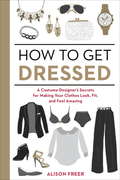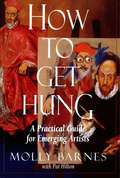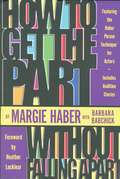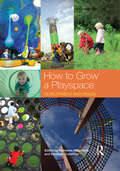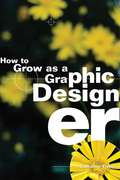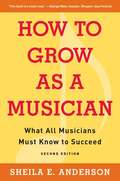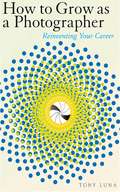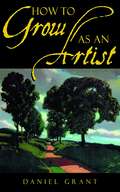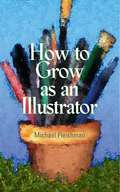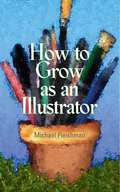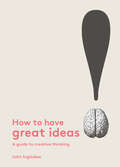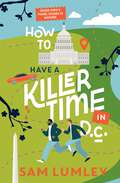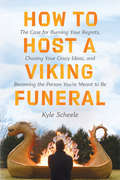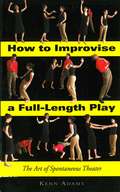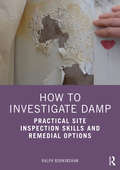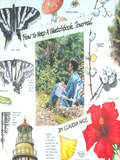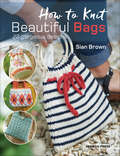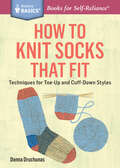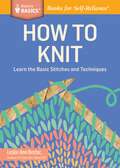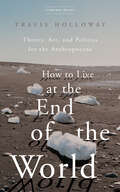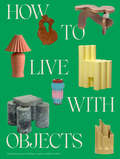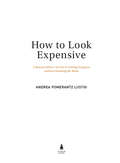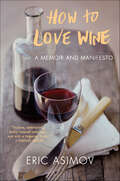- Table View
- List View
How to Get Dressed
by Alison FreerCostume designer Alison Freer's styling kit is a magical bag of tricks, built to solve every single wardrobe malfunction on earth. TV and film productions wait for nothing, so her solutions have to work fast. In How to Get Dressed, Alison distills her secrets into a fun, comprehensive style guide focused on rethinking your wardrobe like a fashion expert and making what's in your closet work for you. She provides real-world advice about everything style-related, including: * Making every garment you own fit better * Mastering closet organization * The undergarments you actually need * The scoop on tailors and which alterations are worth it * Shopping thrift and vintage like a rockstar Instead of repeating boring style "rules," Alison breaks the rules and gets real about everything from bras to how to deal with inevitable fashion disasters. Including helpful information such as how to skip ironing and the dry cleaners, remove every stain under the sun, and help clueless men get their sartorial acts together, How to Get Dressed has hundreds of insider tips from Alison's arsenal of tools and expertise.From the Trade Paperback edition.
How to Get Hung
by Pat Hilton Molly BarnesIn this accessible, easy-to-read, detailed guide for artists, students, and aspiring art professionals, Molly Barnes takes the mystique out of "how to get hung". Readers learn how to present their work and themselves to the professional art world.
How to Get Hung
by Pat Hilton Molly BarnesIn this accessible, easy-to-read, detailed guide for artists, students, and aspiring art professionals, Molly Barnes takes the mystique out of "how to get hung". Readers learn how to present their work and themselves to the professional art world.
How to Get the Part...Without Falling Apart!: Featuring the Haber Phrase Technique for Actors
by Barbara Babchick Margie Haber Heather LoclearHow to Get the Part...Without Falling Apart! is the answer to every actor's audition prayers. Acting coach Margie Haber has created a revolutionary phrase technique to get actors through readings without stumbling over the script. The book helps actors break through the psychological roadblocks to auditioning with a specific, 10-step method for breaking down the scene. Actors learn to prepare thoroughly, whether they have twenty minutes or two weeks. With a client list that includes Halle Berry, Brad Pitt, Kelly Preston, Heather Locklear, Vince Vaughn, Téa Leoni, Josie Bissett, Vondie Curtis-Hall, Laura Innes, and Tom Arnold, among others, Haber encourages and leads the reader through the audition process with helpful and oftentimes humorous examples. Includes script excerpts, celebrity photos, audition stories from today's hottest stars, and tips from top industry professionals.
How to Grow a Playspace: Development and Design
by Katherine Masiulanis Elizabeth CumminsHow to Grow a Playspace takes you through a global perspective of the different stages of child development and the environments that engage children in play around the world. From the urbanity of Mumbai; to rainbow nets in Japan; nature play in Denmark; recycling waste in Peru; community building in Uganda; play streets in London; and gardens of peace in Palestine, it proves that no matter where play occurs, it is ubiquitous in its resourcefulness, imagination and effect. Written by international leaders in the field of play including academics, designers and playworkers, How to Grow A Playspace discusses contemporary issues around children and play, such as risk benefit in play, creativity and technology, insights into children’s thinking, social inclusion and what makes a city child-friendly. With its own ‘Potting Shed’, this text is also a practical guide to support playspace projects with advice on teams, budgets, community engagement, maintenance and standards. How to Grow a Playspace is a comprehensive ‘go-to’ guide for anyone interested or involved in children’s play and playspaces.
How to Grow as a Graphic Designer
by Catharine FishelHelping graphic designers find professional and spiritual support in the ever-demanding struggle to stay creative and profitable, this book reveals how some of today's most successful and intriguing designers keep growing as artists and as people with the power to affect public attitudes. Topics addressed include how to keep track of one's vision, the meaning of success, what sustains designers spiritually, and how to embrace change and stay fluid. Also provided is priceless peer advice on strategic issues such setting a goal for one's company, growing or shrinking a business, and promoting one's uniqueness.
How to Grow as a Musician: What All Musicians Must Know to Succeed
by Sheila E. AndersonA Friendly Guide to Launching and Maintaining Your Musical Career It&’s tough to make a living from one&’s love of music, but Sheila E. Anderson shows readers how to do just that in How to Grow as a Musician. This encouraging yet realistic guide covers everything from developing and learning one&’s craft to managing the business aspects of a musical career. This second edition expands on performance tips, self-promotion tactics, and steps to improve one&’s networking skills to make fruitful connections. Anderson shares her insights as well as practical advice from successful musicians and other industry professionals on topics such as:Composing and recordingUnderstanding and negotiating contractsPutting on a performanceGetting and keeping gigsUtilizing social mediaAnd moreHow to Grow as a Musician is packed with candid views on everything from overcoming failure to the art of writing a song to doing that all-important ego check. Whether they&’re just getting started or have been in the business for years, all musicians will reap the rewards of this thoughtful career guide.
How to Grow as a Photographer: Reinventing Your Career
by Tony LunaAre you bored producing the same old work, but do it because it's safe? Are corporate politics, outsourcing, or the digital revolution too much for you to handle? Has a personal tragedy caused you to reevaluate your career path? If you answered yes to any of these questions, look no further than this inspirational guide. Topics include: --Recognize when something is wrong --Use work-history and personal timelines to meld your passions with your career choices --Reeducate yourself when faced with creative challenges --Embrace risk and evaluate your assets to make your next move --Sell your unique vision through a "Passion First" marketing approach --Manage your time and your business effectively --Use time-management techniques to stay focused and increase your creative output. You will also be inspired by the stories of other creative entrepreneurs who have made their own successful transitions. Whether you are a mid-career professional or just starting out, this book will set you on the path to creative and professional growth.
How to Grow as an Artist
by Daniel GrantIn this definitive guide to resources, aspiring artists and serious amateurs devoted to their art will find scores of time-tested strategies to help them set up and work safely from a home studio; learn where and how to acquire appropriate art materials; develop their abilities with others as well as create art alone; explore opportunities for education in a wide variety of forms; overcome mental blocks; mat, frame, pack, and ship works of art; and much more. Artists looking to show and sell their work will find no-fail ideas for marketing, exhibiting, and entering the world of galleries. Filled with entertaining success stories, this is one volume for the bookshelf of every artist hoping to attain satisfaction and pleasure though his or her art. Plus, dozens of well-known artists-as well as those successful on their own terms-share their own success stories and sources for artistic inspiration.
How to Grow as an Illustrator
by Michael FleishmanFleishman offers guidance for illustrators on how to grow professionally. He covers inspiration, education and starting out, professional development and transitions, career maintenance, teaching, and different markets, as well as mechanical and conceptual skills and how they impact design, process, and product. The business of illustration is addressed, as are marketing and promotion, dealing with failure, and the professional community, and incorporated throughout the book are interviews with active illustrators. There is no bibliography. Fleishman is a freelance illustrator, graphic artist, and teacher of commercial arts. Annotation ©2008 Book News, Inc. , Portland, OR (booknews. com)
How to Grow as an Illustrator
by Michael FleishmanInspiring, practical, and supportive, How to Grow as an Illustrator helps artists find professional and personal support in the struggle to stay creative and make money in their field. Behind-the-scenes interviews with more than sixty of today's most fascinating illustrators reveal how they have kept growing as artists and as individuals. Topics include defining yourself as an illustrator; the significance of art education; mechanical skills vs. conceptual skills; balancing personal and professional lives; dealing with failure; marketing and promotion; how to embrace change; how to stay motivated; and much more. This motivational guide provides real-world guidance and advice for illustrators at every stage of their careers.
How to Have Great Ideas: A Guide To Creative Thinking
by John IngledewHow to Have Great Ideas is the essential guide for students and young professionals looking to embrace creative thinking in design, advertising and communications. It provides 53 practical strategies for unlocking innovative ideas.Strategies include improvisation techniques, changing the scenery, finding hidden links, looking to nature for inspiration, combining unusual systems, challenging set boundaries and many more. Each strategy is packed with great examples of successful contemporary and historical designs – from a designer dress made out of an old typewriter to ticket machines powered by recycled bottles in China, via the reimagining of famous brand logos and mis-use of photocopiers.Packed with practical projects to kick-start inventive thought in idea-blocked moments, this book explores creative thinking across all visual arts disciplines.
How to Have Great Ideas: A Guide to Creative Thinking
by John IngledewHow to Have Great Ideas is the essential guide for students and young professionals looking to embrace creative thinking in design, advertising and communications. It provides 53 practical strategies for unlocking innovative ideas.Strategies include improvisation techniques, changing the scenery, finding hidden links, looking to nature for inspiration, combining unusual systems, challenging set boundaries and many more. Each strategy is packed with great examples of successful contemporary and historical designs – from a designer dress made out of an old typewriter to ticket machines powered by recycled bottles in China, via the reimagining of famous brand logos and mis-use of photocopiers.Packed with practical projects to kick-start inventive thought in idea-blocked moments, this book explores creative thinking across all visual arts disciplines.
How to Have a Killer Time in DC (Oliver Popp’s Travel Guides to Murder)
by Sam LumleyA young, gay, autistic travel writer takes a head-spinning detour when murder and romance unbalance his well-planned life and career in this fun, quirky debut mystery . . . For twenty-four-year-old Oliver Popp, autism is just another fact of life. As long as Oliver sticks to a comfortable itinerary planned well in advance, he gets by just fine as a staff writer for Offbeat Traveler magazine. But a curveball drops into Oliver&’s budding career when his first feature assignment takes him to Washington, DC, to chronicle the latest tourism trends. His freelance project photographer is Ricky Warner, a gregarious and impulsively adorable shot of adrenaline. If the flirty gay photographer isn&’t enough to unbalance shy Oliver at the get-go, there&’s also an unsettling chance encounter with old acquaintance, Elise Perkins, and a congressional hearing that&’s shaking up both the capitol and an entrepreneurial billionaire. The unexpected distractions soon collide—quite literally—when Elise is struck dead by a speeding car. Funny how she didn&’t move and didn&’t scream. She just stared it down like she knew it was coming. Forget the National Mall and Mt. Vernon Square. Oliver and Ricky are game for something much more interesting: solving a mystery and a murder. With their focus shifted and a deadline coming, they only have a few days to solve the crime. For Oliver, it&’s a weeks of firsts: first crush, first time without a schedule, first time playing amateur sleuth, and first time getting wrestled out of his comfort zone. But with a loosey-goosey new partner like Ricky, that might not be such a bad thing at all.
How to Host a Viking Funeral: The Case for Burning Your Regrets, Chasing Your Crazy Ideas, and Becoming the Person You're Meant to Be
by Kyle ScheeleAn inspiring speaker and artist asked 20,000 people around the world to share the regrets they wanted him to burn in a mock Viking ship. This is the story of what he learned about letting go of the pain of the past and embracing the future with hope.Turning 30, artist and speaker Kyle Scheele wanted to do something unusual to mark this milestone. Instead of a birthday bash, he decided to hold a funeral to memorialize the decade of his life that was ending. Building a 16-foot Viking ship out of cardboard, he invited friends to help him set it on fire—a symbolic farewell to his 20s and all the grief, regret, and mistakes that accompanied those years. When video of his Viking funeral went viral, it encouraged many others to let go of past hurts as well. Moved by the response he received, Kyle planned a second funeral (this time with a 30-foot cardboard Viking ship) and asked people to share the things they carried—the bad choices, disappointments, heartaches, and negative thinking that they wanted to lay to rest. He received more than 20,000 responses from around the world—stories both heartbreaking and hilarious, painful and inspiring. In this entertaining and wise book, Kyle reflects on what he discovered about freeing ourselves from the pain of the past, interweaving anecdotes from those who participated with the story of his own journey of renewal. “This story involves multiple Viking funerals, thousands of square feet of cardboard, and enough hot glue to supply your mother-in-law's craft night for the rest of time,” he writes. “But it also involves regret, self-doubt, insecurity, and ultimately, redemption. So buckle up. It's about to get bumpy.”How to Host a Viking Funeral is the story of letting go of the people we used to be, but no longer want to be. It’s about renewal; where there was once regret there is now blank space—an opportunity for a fresh start.
How to Improvise a Full-Length Play: The Art of Spontaneous Theater
by Kenn AdamsForget the script and get on the stage! In How to Improvise a Full-Length Play, actors, playwrights, directors, theater-group leaders, and teachers will find everything they need to know to create comedy, tragedy, melodrama, and farce, with no scripts, no scenarios, and no preconceived characters. Author Kenn Adams presents a step-by-step method for long-form improvisation, covering plot structure, storytelling, character development, symbolism, and advanced scene work. Games and exercises throughout the book help actors and directors focus on and succeed with cause-and-effect storytelling, raising the dramatic stakes, creating dramatic conflict, building the dramatic arc, defining characters, creating environments, establishing relationships, and more. How to Improvise a Full-Length Play is the essential tool for anyone who wants to create exceptional theater.
How to Investigate Damp: Practical Site Inspection Skills and Remedial Options
by Ralph BurkinshawThe aim of this book is to take the reader by the hand and show them exactly how to carry out various inspection techniques to identify the causes of damp in buildings. This is achieved by taking them through a variety of investigation methods using real-life case studies illustrated by dozens of sketches, drawings and photographs – and considerable insight into how investigations can be conducted on site – and also including most importantly the Client’s input and perspective on a damp issue. Written in non-technical language by a leading expert and author on damp, the book begins by outlining the common types and phases of an investigation, the equipment required and the nature of potential remedial work. Case studies then cover condensation, penetrating damp, plumbing and roof leaks, below ground moisture and flooding – and less common causes such as residual construction moisture. The final section contains step by step guidance on procedures such as using a humidity box, inspecting a cavity wall, using a damp meter and extracting and testing a plaster sample for salt content. The book is full of hints and tips developed over a career spent investigating, diagnosing and remediating damp issues and is essential reading for surveyors looking to improve their skills and knowledge of this often complex defect. The book will also be very useful for homeowners trying to self-diagnose, and architects, engineers and other professionals who need to gain insight into common problems caused by moisture imbalance in buildings.
How to Keep a Sketchbook Journal
by Claudia NiceKeep a sketchbook journal and explore your world, preserve your thoughts and celebrate life!More than a diary of written words, a sketchbook journal allows you to indulge your imagination and exercise your artistic creativity. It is a personal, private place where you have unlimited freedom to express yourself, experiment, discover, dream and document your world. The possibilities are endless.In How to Keep a Sketchbook Journal, Claudia Nice shows you samples from her own journals and provides you with advice and encouragement for keeping your own. She reviews types of journals, from theme and garden journals to travel journals and fantasy sketchbooks, as well as the basic techniques for using pencils, pens, brushes, inks and watercolors to capture your thoughts and impressions.Exactly what goes in your journal is up to you. Sketch quickly to capture a thought or image before it vanishes. Draw or paint with care, to render an idea or vision as realistically as possible. Write about what you see. The choice is yours--and the memories you'll preserve will last a lifetime.
How to Knit Beautiful Bags: 22 Gorgeous Designs
by Sian BrownKnitted and crocheted accessories are totally on trend, and bags are particularly popular. They are relatively quick to make and knitters of all abilities can try new techniques that don’t take too long to complete. Sian has created 22 designs in a range of sizes and styles, suitable for beginners as well as more experienced knitters. They include colourwork, lace, cables and texture stitches, and are knitted using a variety of different yarns. All the bags are beautifully finished with coordinating fabric linings, pockets, and wadding to help them keep their shape, and are embellished with knitted flowers, buttons, bows and pompoms. There is a range of designs to choose from, including simple bags, totes, summer bags and evening bags, and the extensive techniques section at the back of the book provides step-by-step guidance on colourwork; embellishments such as surface embroidery, beads, knitted flowers and pompoms; making up and lining your bag; how to attach zips, buttons and other fastenings; and plaited cords and handles. Sian’s delightfully fresh and appealing designs and attention to detail make this an attractive book for all knitters.
How to Knit Socks That Fit: Techniques for Toe-Up and Cuff-Down Styles. A Storey BASICS® Title (Storey Basics)
by Donna DruchunasWhether you’re working socks from the toe up or from the cuff down, designer Donna Druchunas’s complete, step-by-step instructions make sock knitting easy, enjoyable, and successful. You’ll learn several approaches for getting started, and you’ll also discover how to shape comfortable toes, create heels that fit, and ensure stretchy cuffs that can be counted on to keep your socks up. Druchunas’s useful tips and tricks include working confidently with double-pointed needles, knitting socks on one or two circular needles, and even knitting two socks at the same time. Once you’ve mastered these basic techniques, you can adapt them to create your own custom sock designs.
How to Knit: Learn the Basic Stitches and Techniques. A Storey BASICS® Title (Storey Basics)
by Leslie Ann BestorLeslie Ann Bestor makes learning to knit fun and easy. Bestor’s simple, fully illustrated instructions lead you through the basics of knitting, from choosing the right needles and yarn to reading a knitting pattern. You’ll quickly learn techniques for expertly casting on, executing knit and purl stitches, binding off, blocking finished projects, and much more. Even if you’ve never held a pair of knitting needles before, this easy-to-follow guide will have you knitting in no time!
How to Live at the End of the World: Theory, Art, and Politics for the Anthropocene
by Travis HollowayAssessing the dawn of the Anthropocene era, a poet and philosopher asks: How do we live at the end of the world? The end of the Holocene era is marked not just by melting glaciers or epic droughts, but by the near universal disappearance of shared social enterprise: the ruling class builds walls and lunar shuttles, while the rest of us contend with the atrophy of institutional integrity and the utter abdication of providing even minimal shelter from looming disaster. The irony of the Anthropocene era is that, in a neoliberal culture of the self, it is forcing us to consider ourselves as a collective again. For those of us who are not wealthy enough to start a colony on Mars or isolate ourselves from the world, the Anthropocene ends the fantasy of sheer individualism and worldlessness once and for all. It introduces a profound sense of time and events after the so-called "end of history" and an entirely new approach to solidarity. How to Live at the End of the World is a hopeful exploration of how we might inherit the name "Anthropocene," renarrate it, and revise our way of life or thought in view of it. A book on time, art, and politics in an era of escalating climate change, Holloway takes up difficult, unanswered questions in recent work by Donna Haraway, Kathryn Yusoff, Bruno Latour, Dipesh Chakrabarty, and Isabelle Stengers, sketching a path toward a radical form of democracy – a zoocracy, or, a rule of all of the living.
How to Live with Objects: A Guide to More Meaningful Interiors
by Monica Khemsurov Jill SingerFrom the editors of Sight Unseen, an anti-decorating book that champions a new approach to interiors—simply surrounding yourself with objects you love.&“A refreshing, and necessary, counternarrative to shop-this-look consumerism and the aesthetic sameness that afflicts so many interiors.&”—VultureIn the modern home, it matters less whether your interior is perfectly appointed and more if it&’s authentically personal, unique, and filled with the objects you feel a connection to. Through inspiring home tours and practical advice on how and what to collect, Sight Unseen editors Monica Khemsurov and Jill Singer take you on an educational and highly visual journey through the questions at the core of their design philosophy: • What makes an object worth having?• How do our objects impact our lives? Khemsurov and Singer guide collectors, design lovers, and novices alike toward a more intentional and skilled mindset in acquiring and living with objects. The book acts as a detailed primer on how to maximize the visual and emotional impact of your space, regardless of your space limitations, style preferences, or budget. From a deep dive into the world of vintage-hunting to anecdotes about favorite objects from creatives like Misha Kahn and Lykke Li to expert styling tips, How to Live with Objects is an indispensable tool for anyone who wants to make their house a home.
How to Look Expensive: A Beauty Editor's Secrets to Getting Gorgeous without Breaking the Bank
by Andrea Pomerantz LustigGlamour's "Beauty Sleuth" reveals tricks of the trade to help you look fabulously high-end--in any economy. Andrea Pomerantz Lustig has spent twenty years as a beauty editor, and her contact list is packed with the names of the most exclusive stylists in the business. In How to Look Expensive, she combines her own experience with highly coveted secrets she's learned from the experts to help readers achieve buttery highlights, luminous skin, flawless makeup, and more, all on a budget. Delivering red-carpet looks without putting readers in the red, tips include:* How to get expensive-looking hair color at an inexpensive salon* Superluxe DIY skincare cocktails for less than $20* The cheap cosmetic secrets of expensive makeup artists* Tips for princess-perfect skin on a pauper's budget* "Work Your Beauty Budget" sections that help you make the most of every dollarWith How to Look Expensive, every woman can afford to get gold-card gorgeous, and reap the self-confidence that comes with it.
How to Love Wine: A Memoir and Manifesto
by Eric AsimovEric Asimov, the acclaimed chief wine critic for the New York Times, has written a beautiful and thought-provoking combination memoir and manifesto, How to Love Wine.With charm, wit, and intelligence, Asimov tells how he went from writing beer reviews for his high school newspaper on Long Island to the most coveted job in the industry. He evaluates the current wine culture, discussing trends both interesting and alarming, and celebrates the extraordinary pleasures of wine while, at the same time, questioning the conventional wisdom about wine.Whether you’re a connoisseur or a novice, already love wine or want to know it better, How to Love Wine: A Memoir and Manifesto is the book for you.
